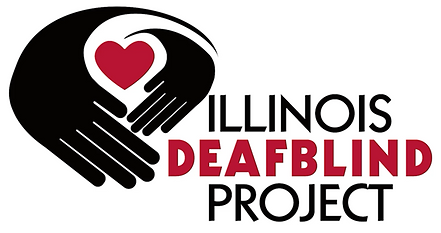What is DeafBlindness?
A child may be considered DeafBlind if they cannot use their hearing to accommodate for their vision, and cannot use their vision to accommodate for their hearing. This includes being considered mildly hard-of-hearing combined with mildly visually impaired, being totally Deaf combined with having no vision, and the spectrum of all combinations of vision and hearing between the two. The majority of children considered DeafBlind have some degree of usable vision and/or hearing. In this brief video Project Reach Coordinator Michelle Clyne describes deafblindness.

This graphic may help explain the “spectrum” of deafblindness. Language in federal law states that children with DeafBlindness are children who “have both auditory and visual impairments, the combination of which causes such severe communication and other developmental and educational problems that such children cannot be accommodated in the early intervention programs solely for children who are hearing impaired or visually impaired.”
Why is it important to know if a child is DeafBlind?
The early identification of DeafBlindness allows the adults in the life of the child to plan and provide:
-
access to the environment in a way the child can see, hear or feel,
-
language access and models that fit the family’s plan and that the child can see, hear or feel,
-
any medical treatments that support that family’s goal for use of vision or use of hearing,
-
timely initiation of interventions (language programs, mentors, therapies), and other critical supports (Anthony, 2016).
The article titled “Identification and Referral with Children with Deaf-Blindness” explains further the importance of identification.
What is the Illinois Deaf-Blind Project (ILDPB)
Illinois Deaf-Blind Project provides technical assistance, information, and training to support families, services providers, and schools in the lives of children who are Deaf-Blind in Illinois. Most of the children served by the ILDBP have and use some degree of vision, hearing or both; but all have a combined vision hearing concern. Project Reach services are provided by a grant and are usually free.
Examples of services include:
-
Child Identification
-
Family to family connections
-
Family Engagement Coordinator support
-
Publications (newsletters, fact sheets)
-
Trainings (for families and professionals)
-
In-class skill building for professionals (through long-term coaching)
Visit the ILDPB website for more information:

If you think a child you know may be Deaf-Blind and you are interested in services, you can email:
.jpeg)
Michelle Clyne, Project Coordinator:
For questions or issues concerning the ILDBP grant administration or other education issues, feel free to contact Lori Clampitt, Project Director, Illinois State Board of Education at:
Additional Resources:
National Center on Deaf-Blindness
National Family Association for Deaf-Blind
Infants and Toddlers who are deafblind should be assigned a Developmental Therapist Vision.
Early Intervention must look at the whole child to determine services. Be sure to open the conversation about a DT-V at your next meeting, here is a short video where Aimee Veith, IL School for the Visually Impaired Superintendant explains what a DT-V is and does.

